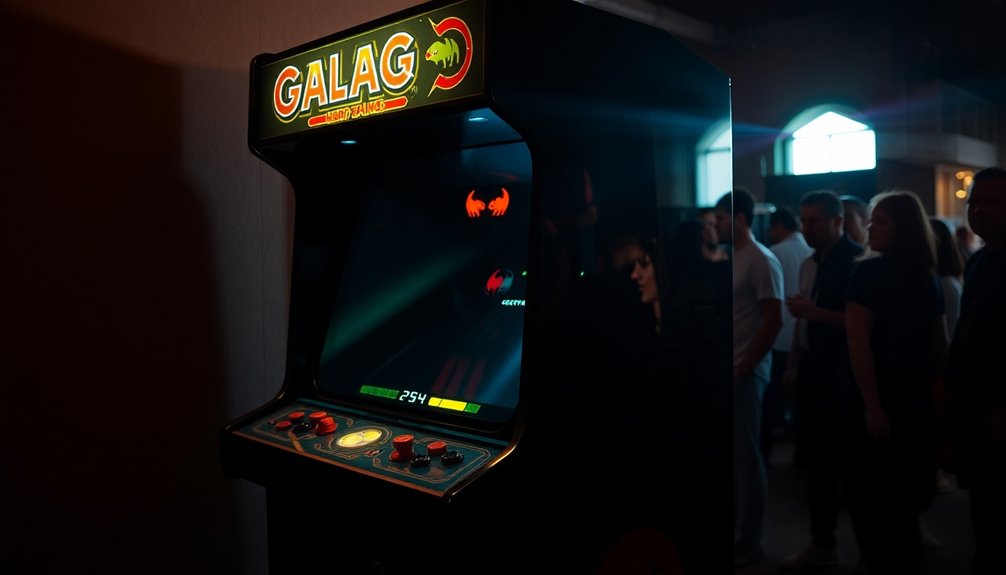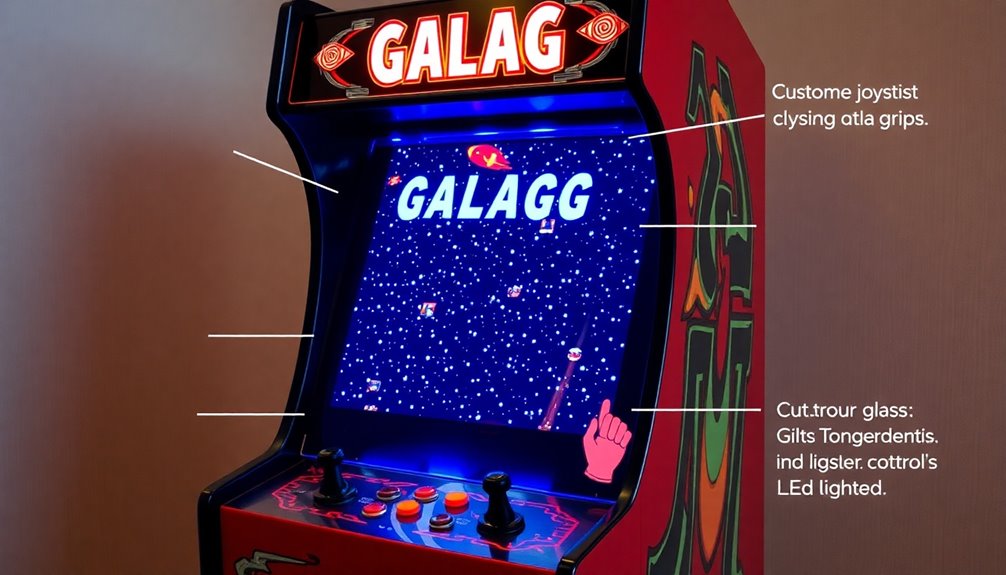Owning an original Galaga arcade machine lets you embrace a significant piece of gaming history. Released in 1981, this classic captures the excitement of battling waves of aliens while utilizing the innovative dual fighter mechanic. You'll experience the thrill of high scores and the competitive atmosphere that once defined arcade culture. Plus, restoring and maintaining your machine connects you to a passionate community dedicated to preserving this iconic game. Whether you're reliving your childhood or sharing it with new generations, your Galaga cabinet opens doors to nostalgia and engagement. Discover how you can enhance your ownership experience.
Key Takeaways
- The original Galaga arcade machine, released in 1981, is a classic that defined the shoot 'em up genre and gaming culture.
- Its innovative dual fighter mechanic enhances gameplay, making it a treasured piece for collectors and enthusiasts.
- The game's enduring popularity is reflected in numerous home console adaptations and mobile versions since its initial release.
- Restoring an original cabinet preserves its historical value and contributes to the legacy of arcade gaming.
- Engaging with the gaming community provides resources and support for those looking to own and restore a Galaga machine.
Overview of Galaga
Galaga is a classic arcade game that epitomizes the thrill of space combat. Released in 1981 by Namco, it quickly became a staple in arcades worldwide, captivating players with its strategic depth and engaging gameplay. You control a starfighter at the bottom of the screen, battling waves of unique enemy types that employ coordinated attacks and unpredictable movement patterns. Each level ramps up the challenge, keeping you on your toes as you navigate the onslaught of Galaga aliens.
One standout feature is the dual fighter mechanic, which lets you rescue captured ships. By doing this, you enhance your firepower and increase your ship's hitbox size, adding a layer of strategy to your gameplay. The colorful graphics and memorable sound effects create an immersive experience that draws you in. Plus, every fourth level introduces bonus stages, allowing you to earn bonus points without any risk, giving you a breather while racking up your score.
Galaga's combination of innovative features and challenging gameplay has cemented its status among the greatest arcade games, influencing countless sequels and adaptations in the world of video games.
Gameplay Mechanics

As you dive into the gameplay mechanics of this iconic arcade title, you'll quickly realize the blend of strategy and skill required to succeed. You control a starfighter at the bottom of the screen, tasked with defeating waves of Galaga aliens that swoop in from the top and sides. The game's dual fighter mechanic is a standout feature; by rescuing captured ships, you can double your firepower, but this also increases your hitbox size, adding a tactical element to your decisions.
Facing the formidable boss Galaga aliens presents an extra challenge, as they require two shots to destroy and can capture your ship with their tractor beam. This not only tests your reflexes but also your ability to plan ahead. Every fourth stage offers a bonus round, where you can rack up extra points while the aliens remain inactive, providing a refreshing break from the action.
The scoring system encourages competitive gameplay, rewarding you with additional points for completing stages and executing specific maneuvers. Mastering these gameplay mechanics is essential if you want to dominate the leaderboard in this classic arcade game.
Development and Releases

In just a couple of months, a small team at Namco, led by Shigeru Yokoyama, transitioned from the Galaxian arcade board to develop what would become the beloved Galaga. This focused development effort culminated in the game's release in Japan in September 1981, followed by a North American release by Midway Games in October of the same year. Galaga quickly gained traction in arcades, becoming a commercial success that captivated players with its engaging gameplay.
As its popularity soared, multiple home console releases expanded Galaga's reach. Platforms like the MSX, Atari 7800, and NES featured the game, along with unofficial ports such as "Zalaga" for the BBC Micro and Acorn Electron. The Game Boy version, released in Japan in 1995, added to its legacy, while mobile versions for i-Mode in 2001 and EZweb in 2006 showcased its enduring appeal across various devices.
In 2006, the Xbox Live Arcade release introduced online leaderboards, enhancing competitive play. Through these continuous releases, Galaga not only solidified its status in arcades but also carved a permanent niche in the hearts of gamers everywhere.
Reception and Legacy

Upon its release, Galaga quickly garnered widespread acclaim, ranking as the sixth highest-grossing arcade game in Japan in 1981. It consistently made waves in North American sales charts from 1980 to 1987, solidifying its status in gaming culture. Players praised its innovative gameplay mechanics and addictive nature, setting a new standard for the shoot 'em up genre.
Galaga's legacy is evident in the numerous sequels and spin-offs it inspired, including Galaga '88, which kept the spirit alive in the arcade cabinet scene. Competitive play remains central to its legacy, with high score tournaments tracked by organizations like Twin Galaxies, reflecting the dedication of its player community.
As one of the greatest arcade games of all time, Galaga not only shaped the gaming landscape but also influenced popular media, appearing in films like "WarGames" and "Pixels." Its presence in modern gaming events and nostalgia-driven venues continues to engage new generations of players. Ultimately, Galaga's impact on the gaming world ensures it remains a beloved classic, cherished by both longtime fans and newcomers alike.
Cultural Impact

Galaga's influence extends far beyond its arcade roots, embedding itself in popular culture and shaping the landscape of gaming. Released in 1981, this iconic video game quickly became one of the highest-grossing arcade games in Japan and maintained strong sales in North America until 1987. Its innovative mechanics, like the dual-fighter system, set a new standard for shoot 'em up titles, influencing countless games in the genre. The comparative advantage principle in game design reflects how Galaga's unique features have paved the way for future innovations. Moreover, its success contributed to the rise of classic arcade games, which defined a generation of entertainment. In fact, the game's pioneering design elements are often cited as influential mechanics that inspired many modern shooters. Additionally, the game's popularity parallels the rise of cloud gaming technology, which has transformed how players access and enjoy games.
The cultural significance of Galaga is evident in its pop culture references, appearing in films such as "WarGames" and "Pixels." Television adaptations, including "Galaga Chronicles," showcase its lasting impact on our entertainment landscape. With its legacy preserved in numerous Namco compilations, Galaga remains a staple in modern gaming, ensuring that new generations discover its charm.
Additionally, the game's ongoing presence in annual high score tournaments highlights its role in shaping gaming history and fostering community engagement among players. You can see how Galaga's blend of nostalgia and innovation continues to resonate, making it not just a game but a vital part of our shared cultural experience. Moreover, its classic gameplay has led to many remakes and adaptations that keep the spirit of the original alive for future audiences.
Competitive Play

While many players enjoy Galaga casually, a dedicated competitive scene has emerged that showcases both skill and strategy. High score tournaments are held globally, with organizations like Twin Galaxies tracking competitive scores and fostering a vibrant community of players. As of 2020, the world record score for Galaga stands at an impressive 20,980,450 points, achieved by player Jordan Dorrington.
The simplicity of Galaga's mechanics makes it easy for newcomers to jump into competitive play. Yet, it offers enough depth for seasoned players to develop advanced strategies that can significantly boost their scores. In these tournaments, you'll often see competitors employing various tactics, from mastering optimal enemy patterns to executing effective ship rescue strategies.
This blend of accessibility and complexity keeps Galaga relevant in the gaming world, continually inspiring new generations of arcade enthusiasts and competitive gamers. The thrill of pushing for personal bests and aiming for the top score creates an exhilarating atmosphere, making each tournament a unique and exciting experience for all involved. If you're looking to test your skills, the competitive Galaga scene is waiting for you.
Restoration and Maintenance

As competitive play continues to thrive, many enthusiasts are turning their attention to restoring original Galaga arcade machines to preserve the game's legacy. When you embark on this restoration journey, start by assessing the cabinet's structural integrity. Many older units may have cracked bases or water damage that needs addressing. To maintain the cabinet's original aesthetic, consider using specialized vendors like Phoenix Arcade for replacement side art and control panel overlays.
Applying wood hardener to MDF components enhances durability and helps prevent further deterioration over time. When making repairs, using biscuit joints for attaching replacement pieces can significantly improve the overall structural stability of the cabinet. Keeping the original components during restoration is crucial, as it preserves the machine's historical value.
Don't forget to document your restoration process. This not only helps you track your progress but also benefits future restorers in the community. By sharing your experiences, you contribute to the collective knowledge, ensuring that the art of restoring Galaga machines continues to thrive. With careful maintenance and attention to detail, you can keep this iconic game alive for generations to come.
Technical Modifications

When diving into technical modifications for an original Galaga arcade machine, you should focus on enhancing both its aesthetic appeal and functional performance. Many Galaga machines have undergone arcade conversions, which can lead to a mix of components that may not align with the original specifications. To restore the cabinet to its former glory, consider replacing the control panel overlay (CPO) to freshen up its look and ensure a smooth gaming experience.
Don't overlook the coin door, as it's a key feature that contributes to the nostalgia of the arcade experience. Restoring or replacing the coin door can significantly improve both aesthetics and functionality. Additionally, applying wood hardener to any MDF sections affected by water damage or wear can bolster the cabinet's durability during restoration.
Keep in mind that some Galaga PCBs might have serial numbers that don't match the cabinet's, which is common due to factory conversions. By addressing these technical modifications, you'll not only enhance the visual appeal of your Galaga arcade machine but also ensure it operates reliably for years to come. Enjoy owning a piece of gaming history and make it your own!
Community and Support

Having improved the technical aspects of your original Galaga arcade machine, you'll find that engaging with the community can be incredibly rewarding. Online forums like the Museum of the Game® and the International Arcade Museum® are great platforms for restoration enthusiasts. These spaces allow you to share your experiences and seek advice on cabinet restoration. You'll quickly discover that the interaction statistics reveal a wealth of knowledge, with discussions often attracting hundreds of views and countless comments from seasoned restorers.
Community support is crucial for newcomers. Documenting your projects not only helps you but also contributes to a collective knowledge base that aids others in identifying cabinet types and components. Engaging with fellow enthusiasts can lead you to find essential replacement parts, artwork, and logos, like the Midway logos for coin doors, which enhance your project's authenticity.
To get the most out of community interactions, post detailed photographs of your cabinet's condition. This way, you'll receive accurate assessments and recommendations from experienced members, highlighting the collaborative nature of arcade restoration. Embrace this community; it's a valuable resource on your journey to restoring your Galaga machine.
Frequently Asked Questions
What Year Did Galaga Arcade Game Come Out?
Galaga arcade game hit the market in Japan in September 1981, followed by its North American release in October 1981. You'll find its signature gameplay made it a beloved favorite in arcades worldwide.
What Was the First Arcade Game Ever Made?
The first arcade game ever made was Computer Space, released in 1971. Developed by Nolan Bushnell and Ted Dabney, it challenged players to pilot a rocket ship against flying saucers, setting the stage for arcade gaming.
What Is the Story Behind Galaga?
Galaga emerged in 1981, evolving from Galaxian's success. You'll experience its innovative dual fighter system, enhancing gameplay. This beloved classic captivated players and became a cultural icon, influencing countless sequels and remaining a staple in arcades.
Which 1972 Game Became the First Commercially Successful Arcade Video Game Machine?
You might be surprised to learn that Pong, released by Atari in 1972, was the first commercially successful arcade video game. Its simple, engaging mechanics sparked a revolution in arcade gaming, captivating players everywhere.
Conclusion
Owning an original Galaga arcade machine isn't just about having a cool piece of gaming history; it's a chance to relive the excitement of classic arcade gameplay. With its engaging mechanics and lasting legacy, Galaga connects generations of gamers. Whether you're a collector or just a fan, this iconic machine brings nostalgic joy and a sense of community. So, dive into the world of Galaga and keep the spirit of retro gaming alive!








